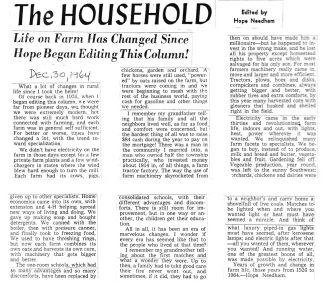What a lot of changes in rural life since I took the helm!
Of course back in 1926, when I began editing this column, we were far from pioneer days, we thought we were extremely modern, but there was still much hard work connected with farming, and each farm was in general self sufficient. For better or worse, times have changed a lot, with the trend toward specialization.
We didn't have electricity on the farm in those days except for a few private farm plants and a few wind-chargers in states where the wind blew hard enough to turn the mill. Each farm had its cows, pigs, chickens, garden and orchard. A few horses were still used, "powered" by oats raised on the farm, but tractors were coming in and we were beginning to mesh with the rest of the business world, paying cash for gasoline and other things we needed.
I remember my grandfather telling that his family and all the neighbors lived well, as far as food and comfort were concerned, but the hardest thing of all was to raise $84 cash during the year to pay on the mortgage! There was a man in the community I married into, a man who owned half the township practically, who invested money about 1914 in, of all things, a farm tractor factory. The way the use of farm machinery skyrocketed from then on should have made him a millionaire -- but he happened to invest in the wrong make, and he lost all his property except homestead rights to five acres which were salvaged for his only son. For most farmers machinery really came in, more and larger and more efficient. Tractors, plows, hoes and disks, cornpickers and combines, always getting bigger and better, with rubber tires and extra comforts, by this year many harvested corn with gleaners that husked and shelled right in the field.
Electricity came in the early thirties and revolutionized farm life, indoors and out, with lights, heat, power wherever it was wanted. We relinquished many farm facets to specialists. We began to buy, instead of to produce, milk and bread and butter, vegetables and fruit. Gardening fell off. Vegetable production, year round, was left to the sunny Southwest; orchards, chickens and dairies were given up to other specialists. Home economics came into its own, with extension and 4-H helping spread new ways of living and doing. We gave up making soap and bought detergents. We canned with the boiler, then with pressure canner, and finally took to freezing food. We used to have threshing rings, but now each farm combines its own oats and harvests its own corn, with machinery that gets bigger and better.
The one-room schools, which had so many advantages and so many discomforts, have been replaced by consolidated schools, with their different advantages and discomforts. There is still room for improvement, but in one way or another, the children get their education.
All in all, it has been an era of marvelous changes. I wonder if every era has seemed like that to the people who lived at that time?
I remember my grandmother telling about the first matches and what a wonder they were. Up to then, a family had to take good care their fire never went out, and sometimes, if it did, they had to go to a neighbor's and carry home a shovel full of live coals. Matches to be lighted when and where you wanted light or heat must have seemed a miracle. And think of what luxury piped-in gas lights must have seemed, after kerosene lamps; and electric lights after that -- all you wanted of them wherever you wanted! And running water, one of the greatest boons of all, was made possible by electricity.
Years of growth and change i farm life, those years from 1926 to 1964. -- Hope Needham.

